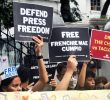by Ardee E. Delola
It’s been five days since Yolanda raged across Visayas. Since then, we are hounded with images of the staggering destruction, of survivors resorting to desperation, and of dead bodies left aground like useless rubble piling up around.
We are hurt and compelled to move. We want to lend our strength to rescuers scavenging for signs of death and life, to people sending out relief and medical assistance, and even to law enforcers struggling to restore order amidst the chaos.
We are inspired by stories of heroism. We are moved by simple acts of kindness. And we are thankful for the outpouring of help and sympathy from around the world.
This is the bayanihan spirit our ancestors taught us. The kind of attitude needed in these trying times.
But as a Filipino, concerned like you, this catastrophe also angers me.
In an interview with CNN’s Christiane Amanpour, President Noynoy Aquino reiterated the statement he made earlier that the local government particularly Tacloban City failed on its preparation and response. The terrifying force of the typhoon was unprecedented and it overwhelmed the ability of local personnel who were also victims themselves, he added.
Hearing this, my jaw dropped in disbelief.
How can he, the country’s Commander in Chief, have the guts to put the blame on the locales when early warnings already suggest that this was a colossal calamity that needed national attention? Days before Yolanda smashed into the Philippines, experts already concluded that this was one of the strongest, if not the strongest typhoon in recorded history.
In the Philippines, disaster prevention and response failed altogether. Despite the glaring fact that our country is at constant danger for lying at the path of natural hazards, there has been no system in place to reduce the risks. Year after year, millions of poor Filipinos living in vulnerable communities dance with death as they face typhoons without needed knowledge and prevention.
How can you blame an old man for refusing to leave his house because no one made him understand that the forthcoming typhoon was unlike any he has experienced before? How can you blame residents for not seeking higher ground because they were not aware of the possibility of a storm surge?
Who should see this coming? It’s the government.
But typhoon after typhoon, officials get away by saying that nature is unpredictable. That the havoc of a monster storm was too extraordinarily fierce to be anticipated. When Bagyong Pablo battered Davao Region last December, many were convinced that vast damages and high death toll were unexpected because the typhoon took an unusual point of entry.
We can’t go on like this. We can’t go on accepting that we have no match against nature. And most importantly, we can’t go on pretending to be resilient when reality shows us that we have weak defenses.
In this country, the common tao expects the President to be the Charles Xavier and his officials, the X-Men.
It is their responsibility to protect us against the menaces of nature. It is their job to ensure that early warnings reach everyone, to enforce an effective evacuation plan that includes mapping out escape routes, stocking up on food, water, medicine and other basic necessities at prearranged temporary shelters and deploying additional security forces, rescue teams, and medical personnel even before disaster hits ground, and to administer a systematic and prompt response to relief and recovery needs. It is their moral obligation to guarantee that every Filipino knows what to do and where to go when a calamity is coming.
In Cuba and Japan, credited as two of the most well prepared disaster-prone countries, knowledge saves lives. And they practice to make it perfect. For God’s sake, we don’t even have typhoon drills! We’re not even taught how to swim in school!
There has to be a corroborated system of disaster prevention and action embedded in every Filipino mind even to that of a child. It is not being alarmist. It’s called better safe than sorry.
In the aftermath of Bagyong Pablo, Naderev Saño of the National Climate Change Commission made an emotional plea to world leaders at the UN Climate Change Summit to stop turning a blind eye on climate crisis. Almost one year later, in the light of a deadlier typhoon, he made the same appeal at the same convention but this time sounding more emotional and with more conviction.
He was speaking of the effects of global warming, which includes a change in climate resulting to extreme weather conditions. This is too scientific for an average Filipino to grasp. However, it doesn’t take a scientist to understand that even without this complex “climate madness”, there are risks for having typhoons as a constant visitor.
So I wonder, if only the government heeded these warnings long before Yolanda, Pablo, Sendong, and Ondoy, how many families would have been spared from grieving?
While today is the right time to give comfort to our fellow Filipinos in Visayas, it will also help them if we protest. Let’s push Malacañang to stop its utter neglect. Let’s show them anger the way we do to Napoles because neglect also robbed thousands of Filipinos of the chance to live.
Let’s not wait for another Yolanda. We can act now.
Ardee Delola is a writer and producer for GMA Network Davao





![[ANALYSIS] A different drug war](https://davaotoday.com/wp-content/uploads/2024/09/1000019103-110x100.png)




